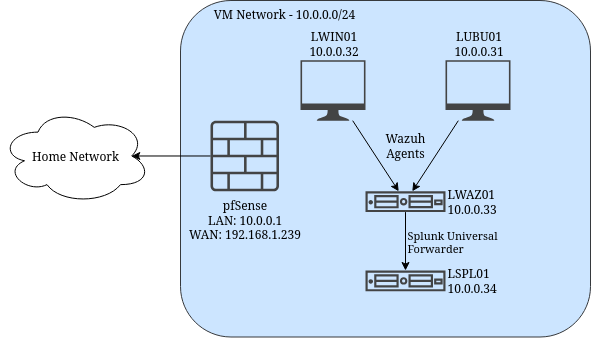Deploying my Home Lab
As an aspiring security professional, there aren’t many things better than a home lab to help you learn and grow. Over the past year or two I’ve ran some experiments here and there with my Intel NUC 11, but nothing very serious or regularly maintained. My recent internship, however, has filled my head with ideas for different things I want to try out on my own.
As enterprise networks are constantly growing and changing, so too will my lab. This post will go through what will serve as my foundation for future projects. It will not be a step-by-step guide, but instead an overview of my current home lab deployment, any issues I ran into setting it up, and future plans.
Tool Choice
pfSense
- Already deployed on my Proxmox server.
- Serves as the network gateway for VMs and enforces segmentation.
- Offers NAT, DHCP, and basic firewalling to simulate enterprise perimeter defenses.
- Will later support IDS/IPS functionality via Suricata or Snort.
Wazuh
- Chosen for its full-featured open-source EDR capabilities.
- Handles file integrity monitoring, log analysis, vulnerability detection, and threat intelligence integration.
- The Wazuh manager (LWAZ01) aggregates logs from both Linux and Windows agents and performs real-time analysis.
- Integrates with both Splunk and Elastic Stack, offering flexibility in future expansions.
Splunk
- Widely used commercial SIEM platform with extensive support for log ingestion and correlation,
- In this setup, acts as the central SIEM, receiving enriched and normalized logs from the Wazuh manager,
- Helps visualize alerts and patterns from agent telemetry.
Deployment Summary
The below table describes the machines deployed in my lab.
| Hostname | OS | Components | User |
|---|---|---|---|
| LWAZ01 | Ubuntu 24.04 | Wazuh Stack, Splunk UF | king-cold |
| LSPL01 | Ubuntu 24.04 | Splunk Enterprise | king-cold |
| LUBU01 | Ubuntu 24.04 | Wazuh Agent | john-doe |
| LWIN01 | Windows 10 | Wazuh Agent, Sysmon | bob-brown |
The below diagram shows how data will generally flow. Everything on the 10.0.0.0/24 network is virtualized and must pass through pfSense in order to reach the internet or my home network (though access to my home network is restricted to my default gateway to reach the internet).
Issues
OS installations went quite smooth, the Wazuh assisted installation method was simple to follow and quick, but Splunk posed a bit more of a challenge. The actual installation of it was not a challenge, but getting LSPL01 to actually receive and process the logs sent by LWAZ01 took some trial and error.
After installing the Splunk Universal Forwarder on LWAZ01, I expected LWAZ01 would begin any alerts from Wazuh straight to Splunk. To my surprise, I was getting absolutely nothing on the Splunk end of things. And so began the troubleshooting.
My troubleshooting methodology was as follows:
- Confirm packets were being sent by Splunk UF by inspecting its logs at
/opt/splunkforwarder/var/log/splunk/splunkd.log. Splunk UF could not establish a connection toLSPL01onTCP/9997. ss -tulpn | grep 9997revealed that no processes were listening onTCP/9997. Upon doing some research, it turns out that receiving onTCP/9997must be enabled. After enabling it in the UI, still nothing in Splunk.Inspect the logs on
LSPL01at/opt/splunk/var/log/splunk/splunkd.log. Grepping for9997, I find the below error log:1 2 3
ERROR TcpInputConfig [41164 TcpListener] - SSL context cannot be created due to missing required serverCert parameter from [SSL] stanza. Will not open splunk to splunk (SSL) IPv4 port 9997
- Research the error. It seems Splunk needs an
inputs.confwith an[SSL]stanza. I know where the certificate is, but it is encrypted and I do not know where the password is so I regenerate it. The SSL stanza is automatically populated with the correct fields. - After restarting Splunk, I’m still running across the same error. I’m not having any luck after playing around with additional parameters either.
- Try disabling SSL. This works and logs are now being received on
LSPL01, but forwarding is no longer encrypted.
For now I’ve left SSL disabled. This, however, is an issue I intend on returning to when I dive into Splunk hardening. Ideally, I would like to have mutual authentication between Splunk server and forwarders among other things.
Conclusion
With the foundation of my lab built out, I can now move onto making improvements and building out additional functionality when time allows. Below I’ve listed a few of the things I intend on working on, though I’m quite limited on RAM right now (With all of the above virtual machines running, my server is running at 29/32 GB):
- Endpoint Hardening
- Wazuh has a compliance checking module that allows me to compare endpoint configurations to their respective CIS hardening benchmarks.
- Active Directory
- To move beyond local user accounts and more adequately mimic an enterprise environment, I can deploy a domain controller on my network and join all of my machines to it.
- Splunk Hardening
- As mentioned earlier, there is still more I want out of Splunk. I’d like to take a look at what else I can do with it since I’ve barely even scratched the surface.
- Create Alerts & Test with Atomic Red Team
- What good is a SIEM and EDR if you’re not using and customizing them? I’d like to perform some malicious activities on my network to see what gets picked up, what doesn’t, and how I can set up useful, accurate alerts.
There is a lot I want to do in this lab environment, so this post likely won’t be my last. Stay tuned for more.

